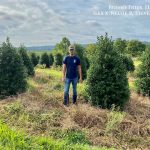One of my earliest memories is being five years old and helping my father install several dozen balled and burlapped trees at a newly constructed retirement community in the mountains of North Carolina.
“Ok,” he said. “Here is how I am going to pay you. I will give you one cent for every tree that you water and two cents for every tree that you spread mulch around after it has been planted.”
“Wow,” I thought, looking at the pile of trees and shrubs upon the ground. “I’ll be rich.”
It seems that my entire life from that moment forth, both professionally and personally, has involved a strong tree component. I have studied, cultivated and admired trees and have been compared to a modern-day Johnny Appleseed. During most of this time it has seemed to me a one-sided relationship, in which I controlled and manipulated the trees for my own purposes. However, as I began to study trees and plants further, peeling back the layers, I discovered a world far more sophisticated than originally imagined. As it turns out, plants have been educating me all along and I didn’t even realize it.
Due to the stationary nature of trees and plants, they have long been considered by the masses to be a lower level of organism, devoid of many of the characteristics we associate with complex life. Recently, scientific and technological advances have allowed for the mapping of the genetic code or genome of many plants and animals. This biological code is responsible for the development of all living creatures, creating a map into the future, triggering normal growth, development, aging and dying. This genetic code is also a map into the past, reflecting every step of evolution from conception until present.
At first, it was assumed that the size and complexity of a specific genome reflected the sophistication of a species in terms of their ability to adapt. Primates would naturally contain the longest genetic code, with modern humans atop the list. Many were surprised to learn that the genetic code of plants is often far larger than that of animals. Pieris japonica, the elegant ornamental plant native to Japan, boasts a genetic code fifty times larger than that of human beings. Many of the world’s plants have borne witness to vast periods of times and cataclysmic environmental change, adapting and evolving with a goal of survival and reproduction.
I began to revel in the achievements and capabilities of the trees I work amongst, noting their superior survival and coping skills when compared to those of my own. I grew envious of their ability to shut down and enter dormancy when adverse conditions arise. Deciduous plants opt to sleep the entire winter, avoiding the cold days and lack of light that many of us dread. Evergreens, whose time upon the earth far exceeds that of deciduous plants, nap only when necessity dictates, and awaken at the first inclination of favorable conditions.
There is considerable evidence suggesting the prominence of plant to plant communications. This includes sounding the alarms of danger, as well as the sharing of nutrients, water and other vital elements. The pungent aroma associated with mown grass in spring is, in reality, a chemical form of communication, in which the local community is warned of approaching danger. Adjacent grasses may then pull vital elements back into their root systems, so as to be available when regrowth commences.
While the plant kingdom is not exempt from the perils of competition, there are many examples of sharing and cooperation amongst localized plant communities. Trees in the forest are connected through their roots via mycorrhiza, a filamentous fungal network, whose interwoven threads spread nutrients and chemical signals amongst neighbors. There is evidence to suggest that this dispersion is not blind, random or self-serving, but equitable and charitable, at times motivated by the needs of the community as a whole. In some instances, carbon, injected into the leaves of the largest, most vigorous trees in a stand, has been traced and eventually relocated in the foliage of the weakest trees, providing much needed energy. In a sense, the most powerful and successful members of the community are gifting their excess to those who need it most.
It can be stated unequivocally that hydration, nutrition, PH and environment are key factors in determining a trees ability to thrive in a particular environment. In most instances, when problems arise amongst specific trees in the nursery they are a symptom, and the cause may be associated with one of the factors listed above. Addressing the cause, rather than the symptom, leads to increased vigor and a reduction in the need for chemical inputs.
Each growing season in the nursery seems a new learning experience all together, as last year’s problems are studied and conquered, new ones arise from places unforeseen. Few rules apply to every tree and old-fashioned observation seems the highest form of learning. Luckily, I am surrounded by teachers and all I have to do is observe and listen. I am motivated to eat cleaner, live better, and contemplate the environment around me. I value more than ever the importance of open and honest communication. Like I was told as a kid, sharing actually is caring. I remind myself that the world is not mine alone, but that I am part of a greater community and what is good for my neighbor is good for me. I strive to judge less and care more, for there is room for us all to grow, with a little cooperation.
Recently I drove past the retirement community that I first planted with my father, thirty-six years prior. Conifers that were no larger than me when I was five now stretch thirty feet into the air and appear to have been there forever. They are still in their youth and should remain long after I am gone. They appear wise, like venerable professors overlooking the town of Boone. I stopped and listened and wondered what they would teach me next.

